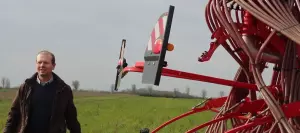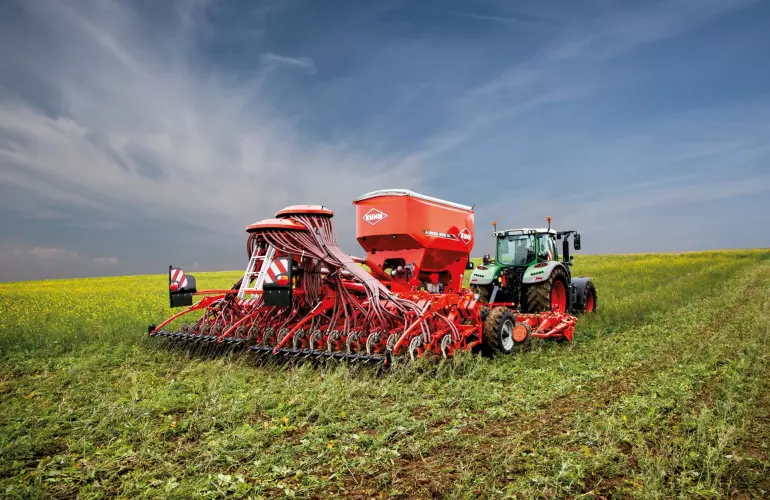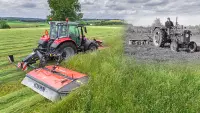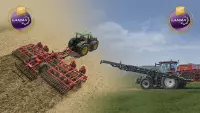NEW DRILL CENTRAL TO SUSTAINABLE SYSTEM
Proactive engagement with progressive farmers is an integral part of KUHN UK’s market communications strategy.

This can involve collaboration on the development of new machines or working with leading farmers as products are fine-tuned prior to their full market launch.
Cambridgeshire arable farmer Martin Lines is a good example, firstly through his early adoption of KUHN’s Performer single pass cultivator and more recently as one of the first to trial the Aurock drill in the UK.
Martin is on a journey to build a more sustainable business at his 540ha operation near Eltisley. With a mix of owned and contract farmed ground, dominated by heavy clay land, his focus is on improving soils through reduced tillage and the widespread use of cover crops. Through this strategy, he’s overcoming the scourge of black grass, reducing agrochemical use and cutting emissions through reduced diesel consumption.
As a natural communicator, Martin is keen to share his story. His use of social media helps him reach out and receive valuable information. Back in 2018 this included a missive on his quest for a drill to work in zero-till conditions and cope with significant cover crop residues. Responding via Twitter, KUHN UK first alerted Martin to the Aurock when it was still in the development phase.
“The Aurock ticked every box on my list, and others I hadn’t considered,” said Martin. “No other drill I know can be had with an integral crimp roller. One thing I’d been seeking was a drill that could cope with cover crop destruction, pulverising it to create ‘soil armour’ but without moving soil, stopping both rain impact on soil and evaporation from it, while also suppressing weeds. On the Aurock it can be put in/out of work as required, with hydraulic downforce for greater effect.

“It also has effective opening discs – they can be lifted out where required or worked deep for oilseed rape – and the ability to specify a full-width set of firming wheels/tyres aids seed/soil contact, action on the cover crop and weight distribution when turning. And the coulter bar pivots and is hydraulically steered so the coulters follow the opener channels.
“With two hoppers and distribution heads, it can drill seed with fertiliser, or two different seed types for cover crop establishment. It can place different seed at different rates in different rows, planting, say, a clover/vetch mix from one hopper and a black oat/bean mix from the other.
“There’s also a separate small-seed applicator. I can plant something with deep-rooting, compaction-busting roots only on headlands, and ordinary cover on the rest of the field. I’m also looking into using companion crops such as clover, where trials indicate improvements in soil condition and pollination and reductions in flea beetle numbers in oilseed rape.
“In our first season, we tried the drill across field surfaces from roughly cultivated to finely-tilled to stubble, and it coped well with all, but as with all direct drills an even soil surface is important. On unworked land it needs relatively little horsepower, but on tilled ground when laden it reins forward speed back to 7-8km/h.”
Martin’s overall shift in strategy includes adopting late autumn drilling and spring cropping and ceasing to move soil at establishment. As a result, he’s seen blackgrass levels in most of his fields reduced dramatically.
The farm’s rotation is now based around a first wheat followed, in low blackgrass fields, by a second. Then come one or two spring crops – usually barley – plus some areas of winter oilseed rape and winter beans. Up to 60% of cropping has been spring-planted, but as blackgrass populations drop, and are kept suppressed by later drilling and cover crops, this is being cut back, with a corresponding rise in high-return first wheats compensating for the investment in cover crops and poorer returns from spring breaks. Cover crop plans will remain unaltered, though.
“With the Aurock crimp roller having proven itself, we have scope to increase combine cutting height. By not chopping and spreading as much straw, I can potentially save £2-3/ha on fuel.
“Meanwhile, we’ve saved considerably on herbicides, good yields have been sustained and we’ve maintained strong gross margins on the wheats. We’re covering the same land in fewer hours, having saved as much as six weeks autumn work, for less expenditure and no yield penalty.
“If progress continues, using minimal soil movement and maximum use of cover crops to help minimise the establishment and maximise the suppression of weeds, I can even see our pre-emergence herbicide, and perhaps any glyphosate we’re still using pre-emergence, being gradually factored out.”
Listen to Martin discuss the Aurock!
Other News

VB 7100 first AEF Certified Section Controlled balers
VB 7100 series balers: the world’s first Section Controlled balers with a GPS automated pick-up.

Over 60 years of drum mower experience
In 1963, Dutchman Piet Zweegers jr. made an important invention: the cyclo mower, or drum mower. It would change the haymaking world forever...

Award-winning innovations from KUHN at LAMMA 2025
KUHN Farm Machinery will return to LAMMA for the first time in five years, showcasing an extensive range of products and innovations, with s...
